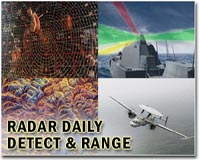 |
Madrid, Spain (SPX) Oct 06, 2010 Researchers at the Universidad Carlos III de Madrid (UC3M) have designed a real application for maritime surveillance that is able to integrate and unify the information from different types of sensors and data in context through artificial intelligence and data fusion techniques. The system has been designed by scientists from this Madrid university for Nucleo CC, a company which develops surveillance systems for the maritime and aeronautic sectors. The first prototype will be used in the near future in Cape Verde (Africa). Two types of sensors have been deployed there: a set of radars and a series of AIS (Automatic Identification System), which allow ships to communicate their position and give other relevant data on their location and characteristics. These two types of sensors offer complementary data which can be fused in order to obtain better information as to what is happening in the maritime and coastal space of the area of interest. This has been achieved by the scientists from the Applied Artificial Intelligence Group (GIAA) of UC3M, who have carried out the project "Fusion de Informacion en Trafico Maritimo" (Information Fusion in Marine Traffic). The results of this research, presented last July at the International Conference on Information Fusion in Edinburgh, Scotland, has been the creation of data fusion software which allows improved maritime surveillance to be carried out, simultaneously integrating the capabilities of the radars and the AIS localization stations deployed. The objective is to guarantee security in the area by monitoring the different ships that are in a given maritime route which, at the same time is the entrance and exit of a commercial port. "For that", Jesus Garcia, one of the heads of the study from the UC3M Department of Information Technology, pointed out, "it is necessary to have a complete, accurate, and up to date picture, similar to that which is provided to air traffic controllers, of all the ships that are in the area of coverage to be able to adequately manage maritime traffic and to detect anomalies as much in advance as possible". The scientists developed a prototype which has been integrated into the company's system, after having undergone validation tests to be able to execute in real time with the data supplied by its sensors. It able to monitor 2,000 identifiable objectives between large and small vessels, with a capacity to process the data of up to 10 sensors and provide the exit with one second refresh time. "Ships have to be able to localized 24 hours a day, 7 days a week, 365 days a year, independent of failures in the sensors or in the different intermediate mechanisms, and in some way, what this system attempts to do is guarantee that this can be done", explained Jose Luis Guerrero, another of the GIAA group researchers, who worked on this project from the UC3M Colmenarejo Campus. "In this way", he continued", we are able to make it so these vessels never lose their position thus avoiding collisions or any type of problem in information management regarding the movement dynamics of these ships". This first prototype opens the way for posterior analysis and development, as more data and information regarding its functioning under real conditions are obtained, the scientists noted, who are now researching how to apply this information fusion technology to fields such as robotics, in unmanned vehicle navigation, artificial vision, or environmental intelligence systems. "In all of these areas", Professor Jesus Garcia pointed out, "information is critical."
Share This Article With Planet Earth
Related Links Universidad Carlos III de Madrid (UC3M) Space Technology News - Applications and Research
 US grants licenses for radar equipment sales to Taiwan
US grants licenses for radar equipment sales to TaiwanWashington (AFP) Aug 25, 2010 US President Barack Obama administration says it has granted export licenses to US firms selling radar equipment to Taiwan in a move that could irk China. Beijing angrily halted military and security contacts with Washington when the United States announced in January an arms package for Taiwan that included missiles, helicopters and equipment for Taiwan's F-16 fighter jets. "We have not ... read more |
|
| The content herein, unless otherwise known to be public domain, are Copyright 1995-2010 - SpaceDaily. AFP and UPI Wire Stories are copyright Agence France-Presse and United Press International. ESA Portal Reports are copyright European Space Agency. All NASA sourced material is public domain. Additional copyrights may apply in whole or part to other bona fide parties. Advertising does not imply endorsement,agreement or approval of any opinions, statements or information provided by SpaceDaily on any Web page published or hosted by SpaceDaily. Privacy Statement |